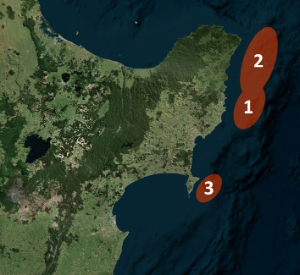
Multiple week-long silent quakes off the East Coast
Updated: Thu Sep 29 2016 1:00 AM
Scientists here at GNS Science are still trying to unravel the details of the East Cape M7.1 earthquake.
To add to this mix, both before and after this month's East Cape earthquake, there have been multiple silent earthquakes (also called slow-slip events) offshore from East Cape and the Mahia peninsula.
The recent spate of silent earthquake activity started at the end of August, around a week before the magnitude 7.1 earthquake. A silent earthquake was picked up on a few of GeoNet's GPS stations off the coast of Anaura Bay (area 1 on the map). It looked as though it was tapering off when the magnitude 7.1 quake struck, kicking the silent earthquake back into life and extended the area of movement further to the north (area 2 on the map). Judging by previous silent earthquakes in the area, this current one has moved the equivalent of a magnitude 6.5 earthquake. In the last few days, while this silent earthquake is coming to an end, another one is starting up offshore of Mahia peninsula (silent earthquakes happen so gradually it's tricky to pick exactly when they start and finish).
How do silent earthquakes relate to traditional earthquakes? How traditional earthquakes and silent earthquakes interact is still a relatively new area of study - there have been many examples of small earthquake swarms associated with silent earthquakes, as well as a few examples of larger quakes and silent quakes happening around the same time. The Gisborne M6.7 earthquake in December 2007 triggered a silent earthquake. With silent quakes happening about once a year off the East Coast of the North Island, they are much more frequent than large earthquakes.
This area of New Zealand is very interesting to other scientists around the world, Japan's Kyoto University currently have sensors on the ocean bottom offshore of Gisborne. Researchers hope that these instruments will build a more complete picture of what happened in both the East Cape M7.1 quake, as well as these silent quakes. Unfortunately scientists are in for a long wait, as these instruments aren't due to be collected until mid-2017.
What are silent earthquakes? Silent earthquakes are undetectable by both humans and GeoNet's seismographs but they can move faults the equivalent of magnitude 5+ earthquakes. A normal earthquake is over in less than a minute, but these East Coast silent earthquakes take anywhere from a week to a month to unfold. We can detect silent earthquakes only with GPS stations, which track land movement. The East Coast of the North Island is slowly pushed west. When a silent quake occurs, the land jumps back towards the east. Silent earthquakes happen at many of the subduction zones around the world - where one tectonic plate dives beneath another.
Want more info?
Listen to a podcast interview of one of GNS's awesome research scientists Laura Wallace talk about everything slow-slip related.

